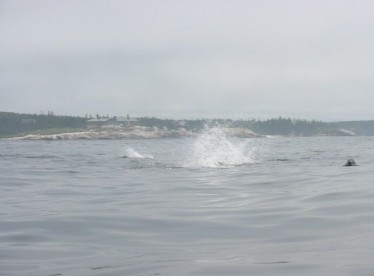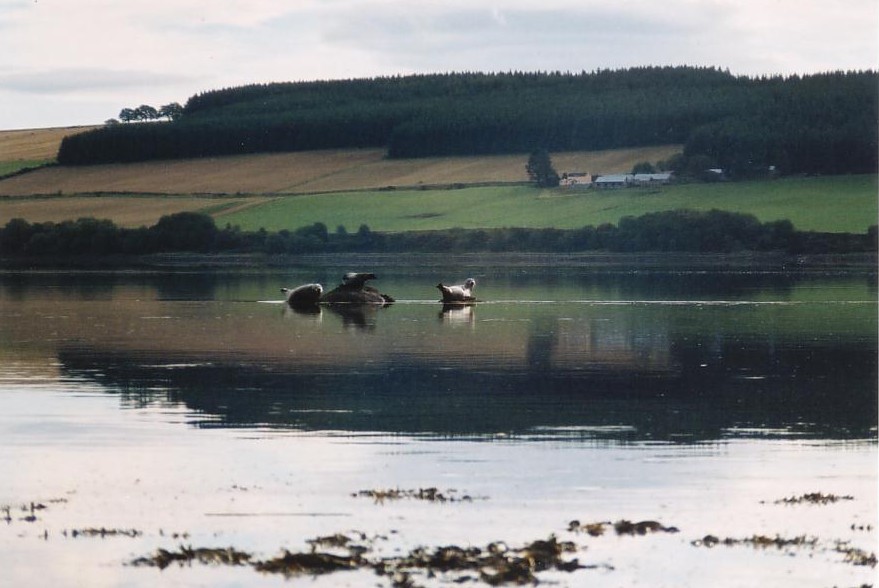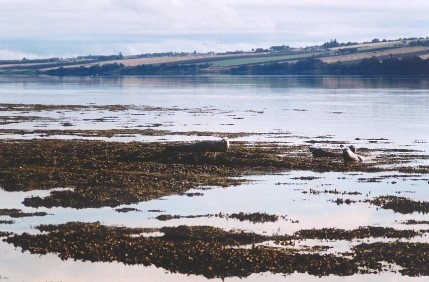BM: Ottawa has authorized a first-ever harvest of grey seals for Nova Scotia that would take place over two years and likely wrap up by the end of 2006.
GSCS: This will not be a "first-ever harvest of grey seals for Nova Scotia." In the eighteenth and nineteenth centuries, grey seals in Nova Scotia were subject to a large-scale commercial harvest for their blubber, after the fishing industry had decimated the great whales and walruses. Beyond this initial unregulated commercial harvest, ongoing aggressive attempts were made to eradicate grey seals from Nova Scotia waters, by fishermen and by the Department of Fisheries and Oceans (DFO). Until a couple of decades ago, a substantial bounty was paid to fishermen by DFO for the jawbones of grey seals. And DFO sent its workers to grey seal whelping colonies each winter to kill as many adults and seal pups as possible. Grey seals were considered vermin, a detriment to the fishing industry, and their total elimination was the goal of this activity. As a result, grey seals were driven to near oblivion. Since the removal of the bounty, grey seal numbers have naturally increased in Nova Scotia.
BM: The seals have been cited as being a major factor in the failure of groundfish stocks to rebound. Herds have been growing rapidly, at about 12 per cent each year, say some studies.
GSCS:
Lacking an appreciation of the serious broad-scale negative changes running
throughout the ocean ecosystem today (falling plankton counts, falling
oxygen content and fertilizer content of seawater), fishermen cling
to the hope that this is true, that seals really are the reason groundfish
stocks have failed to rebound. However, no science supports this line
of thinking. The awkward, unexpected truth of the matter is that groundfish
are now starving, and that this is a scary, unprecedented turn of events.
DFO knows this, and the fishermen know this. DFO scientists have recently
attempted to analyze in detail the changing ocean food web, but they remain
officially mystified by the stunted, starving cod and other groundfish
in Atlantic Canada. The latest hypothesis advanced by DFO, to explain
the lack of food for cod, is that an overgrowth of "small pelagic
fish" (herring-types) is now preventing the normal flow of food to
bottom fish, thus causing their starvation. This overgrowth of "small
pelagics" is thought to have resulted from the unprecedented, near-total
removal of their natural predators, most of who were larger fish. The
only significant natural small fish predators remaining in the sea, that
might conceivably reassert control over the supposed runaway herring population,
are the seals. By this logic, removing seals threatens to further exacerbate
the starvation problem facing groundfish. DFO's ecosystem modelers can
only, in honesty, offer caution against a seal cull at this time.
And they have published exactly this warning in the scientific literature.
However, this part of the story seems to be firmly censored by the fishing
industry, who appear to have the power to silence objective scientific
advice that might be offered by government scientists. This is a long-standing
pattern in the politics of Canadian marine science, and, most times, the
public media simply falls in line too, for instance by repeating the scientifically
illogical mantra that seals are a "major factor in the failure of
groundfish stocks to rebound."
On the other hand, it is entirely plausible that the observed decline
in plankton counts really is a "major factor in the failure of groundfish
stocks to rebound." But there will be no quick fix for this negative
plankton "factor," no amount of discharging of firearms can
help this problem, and killing more sea animals could realistically
contribute to worsening the situation.
BM: DFO has approved a harvest of 10,000 seals over two years. "Certainly the number can be higher and we feel from a scientific point of view that the resource can withstand a higher harvest than that," said Osborne Burke of Ingonish.
GSCS: Mr. Burke is a fisherman. With all due respect, his "feeling from a scientific point of view" cannot be given much weight. Events spanning centuries consistently show that the fishing industry always underestimates its own power to destroy fish and other marine animals. Mr. Burke is seeking financial gain from the grey seal hunt, a conflict of interest that threatens his "scientific" objectivity. He may also be unaware of the ominous plankton decline that threatens the future of both fish and seals, and of the plankton-stabilizing effect of large integrated populations of co-existing seals and fish.
BM: In the 1980s, the grey seal population on the east coast was less than 50,000. The herd is now estimated at about 300,000.
GSCS: This suggests to the reader that a pathological overgrowth of seals may have occurred recently. Perhaps that a "problem" has developed, that should be "fixed?" Prior to commercial exploitation, the grey seal population on the east coast undoubtedly numbered into the millions. Occasionally today, the fishing industry or the media will report that grey seal numbers are now at an "all time high." This is not true, but just an example of the human tendency toward selective memory loss. The fact that any fish predator can still manage to rally at all should be seen as a positive force for future ocean health. Other fish predators in east coast waters today (large fish) cannot grow to large enough sizes to perform their ecological role, due to food shortage. This provides a reason not to remove the seals from a food web that seems now to be in an unprecedented fragile condition.
BM: Seal blubber can be reduced to omega oil and the pelts of juveniles are marketable, say industry sources. Seal meat could be canned and sold in export markets.
GSCS: The marketing of seal products is illegal in the United States, prohibited by the Marine Mammal Protection Act (MMPA). This law is a source of frustration for DFO and others promoting the commercialization of Canadian seals. However, the MMPA reflects the modern values of most people in western countries today: they prefer the sight of marine mammals living unmolested in the ocean to their appearance in the marketplace. Many people also entertain serious concerns about the ability of harvesters to kill any of these intelligent wild animals in a "humane" manner.
BM: Fishermen who choose to harvest seals for their pelts would likely target those at least a year old, Mr. Burke said. Fishermen harvesting seals for their meat would go after the larger adults.
GSCS: The issue of "humane" slaughter techniques will need to be addressed for the grey seal hunt. The sealing industry has successfully framed the harp seal hunt in the public mind as one only of whether or not seals are killed "humanely" (ignoring the question of ecological wisdom).
BM: The Nova Scotia government supports a controlled grey seal harvest, provincial Fisheries Minister Chris d'Entremont has said.
GSCS: Chris d'Entremont may honestly believe that removing seals will aid "the groundfish recovery," but if he does, he is wrong. Unlikely to be speaking from an objective marine ecological perspective, Mr. d'Entremont is more likely to be simply angling for the votes of fishermen.
BM: "We have to submit a harvest plan to DFO," said Denny Morrow of the Nova Scotia Fish Packers Association, who chairs the grey seal society meetings. "We hope to have that in by Dec. 1.
GSCS: Two registered societies in Nova Scotia have been organized specifically to address concerns regarding grey seals. The goals of these societies are diametrically opposed, and to avoid confusion neither the "Grey Seal Conservation Society (GSCS)" or the "Grey Seal Research and Development Society" should be referred to in media reports as simply "the grey seal society."
BM: "Everything hinges right now on getting the funding in place. We're raising some money from the industry and we have also asked government sources for some help." (quoting Denny Morrow)
GSCS: This sounds as if more Canadian tax dollars might be spent financing the reckless destruction of more marine animals, at a time when we have pushed sea life so far that the integrity of the ocean ecosystem itself is teetering. Most Canadians are already opposed to seal killing, but if they understood the full picture, the majority would surely be larger. If Canadians were told frankly that groundfish stocks cannot recover because they are starving, that zooplankton are declining, and that a multitude of small animals are quietly vanishing from the shorelines as a result (clams, mussels, barnacles, snails, even worms)…all truly ominous signals, and decidedly frightening to even non-scientists, then public concern about ocean health might be raised considerably. But sadly, it appears that official Canadian marine science in the 21st century, DFO, is determined to maintain its tunnel vision and feigned innocence, to just forge ahead on the same old dead-end course, and to continue to dumbly condone the slaughter of more seals to placate angry fishermen.
BM: Approval to harvest any marine mammal is up to the DFO and Environment Canada.
GSCS: Elaborate legislation has been written to ensure that the commercial harvesting of seals in Canada is done appropriately and humanely. Enacted mainly in an effort to quell broad public concerns about the "inhumane" slaughter of harp seal pups, the regulations nevertheless specifically cover all commercial sealing, including any such harvest involving grey seals. Commercial sealers must be licensed, and they can only obtain a license after working for two years as an apprentice to another sealer who already holds a professional license. Commercial sealers must ascertain that any seal they have attacked is in fact dead (by administering a "blink reflex" test) before either cutting this seal or proceeding to slaughter another one. Grey seals may not be hunted commercially during their whelping or mating period (January and February) and they may not be hunted at Sable Island.
 Complying
with these regulations will make the proposed Nova Scotia grey seal commercial
harvest rather impractical. The "humane" method for killing
an adult grey seal in the water has yet to be described.
These seals are wary, fast and elusive. What happens now, under the "nuisance
seal" shooting to which thousands of grey seals have already been
subjected in Nova Scotia, is that they are shot at in the water by men
who chase them in fishing boats. Random gunshot injuries result, and grey
seals often die later of their wounds, their bodies never being recovered
by the fishermen, who therefore cannot know how long it took them to die.
Perhaps DFO will find a way to waive all of the existing regulations that
should govern the upcoming Nova Scotia grey seal hunt, in its obeisance
to the fishing industry. They may think that nobody is watching this one,
that the international public eye is only on the Canadian harp seal hunt.
But that assumption is wrong. And if DFO allows commercial seal hunters
to attack the grey seal herd at Sable Island, then the ensuing international
outrage and condemnation of Canada will be fully deserved.
Complying
with these regulations will make the proposed Nova Scotia grey seal commercial
harvest rather impractical. The "humane" method for killing
an adult grey seal in the water has yet to be described.
These seals are wary, fast and elusive. What happens now, under the "nuisance
seal" shooting to which thousands of grey seals have already been
subjected in Nova Scotia, is that they are shot at in the water by men
who chase them in fishing boats. Random gunshot injuries result, and grey
seals often die later of their wounds, their bodies never being recovered
by the fishermen, who therefore cannot know how long it took them to die.
Perhaps DFO will find a way to waive all of the existing regulations that
should govern the upcoming Nova Scotia grey seal hunt, in its obeisance
to the fishing industry. They may think that nobody is watching this one,
that the international public eye is only on the Canadian harp seal hunt.
But that assumption is wrong. And if DFO allows commercial seal hunters
to attack the grey seal herd at Sable Island, then the ensuing international
outrage and condemnation of Canada will be fully deserved.
BM: Old statistics kept by DFO indicate that in January and February of 1963, there were about 230 grey seal pups born on Sable Island, the main rookery for Atlantic Canada.
GSCS: Yes…showing how close we came to extirpating the grey seal from Sable Island in the recent past.
BM: For the same two months this year, the number of seal pups born rose to more than 50,000.
GSCS: This "50,000 pups" is a number that has been extrapolated from the most recent count of grey seal pups at Sable Island, which was done in 1997, when considerably fewer than 50,000 pups were born. This "50,000" assumes that the seal population growth rate has continued without change, but this might not be true. A more accurate estimate of the number of grey seal births should now be available, but inexplicably, it is not. In January, 2004, DFO made a photographic survey of the entire Sable Island grey seal herd with its pups. However, an updated grey seal population estimate has not been provided by DFO, because the analysis of the photographs has not yet been completed, 10 months later. Someone needs to examine the photographic prints with a magnifying glass, and then count the pups…
BM: Some members of a tour group kayaking in Prospect Bay near Bettys Island on July 5 were startled to discover about a dozen grey seals floating dead in the water, apparently shot by fishermen.
GSCS: Confirming the pro-seal killing editorial policy of the Halifax Herald, the newspaper coverage of this particular story omitted the fact that one of those "shot" grey seals was not dead when the kayaking tourists found it. The kayak tour operator who led the group, and who reported this story to the media, also pleaded with DFO and the Department of the Environment for a solid week to have someone come and kill a lone wounded seal that was suffering on the shoreline. Government officials refused to deal with this, citing "no resources," and the grey seal eventually died, one week after it had been shot.
BM: The Grey Seal Research and Development Society hopes to be harvesting grey seals this winter.
GSCS: The Grey Seal Conservation Society (GSCS) hopes the public will wake up to the ocean crisis before it is too late, and will condemn the politically sanctioned new grey seal hunt. GSCS also hopes that DFO will soon find the integrity to become the "international leader" in marine science and "resource management" that it officially aspires to be.

